Cats
Top Cat Breeders in Minnesota: Your Guide to Feline Friends
Step into the world of top cat breeders in Minnesota, where excellence meets feline companionship – find your purrfect match today.
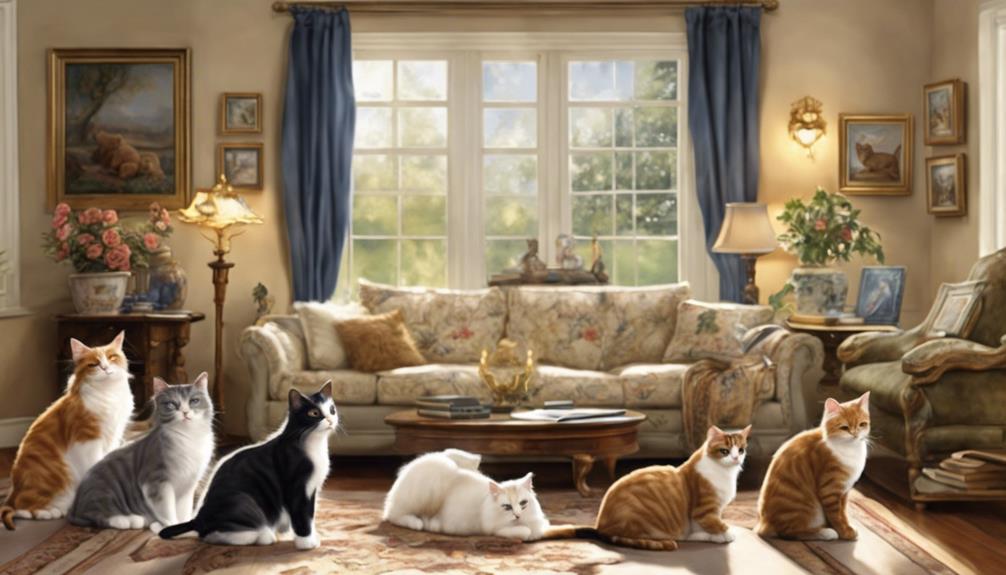
When looking for top cat breeders in Minnesota, we have gathered a list of reputable establishments that excel in breeding and care. Whether it’s Twin City Cat Fanciers, Inc hosting annual cat shows in Crystal, MN, or Purrfect Paws Cattery focusing on breeding Scottish Fold and British Shorthair cats in Eagan, MN, each breeder provides distinctive qualities for feline lovers to consider.
Let's explore these feline friends further to discover the one that best fits your needs.
Key Takeaways
- Minnesota Meow Manor specializes in breeding high-quality Maine Coon cats with a focus on health, temperament, and breed standards.
- Purrfect Paws Cattery in Eagan breeds Scottish Fold and British Shorthair cats, ensuring healthy, well-socialized kittens with pedigrees and health assurances.
- Feline Friends Breeder in Olympia rescues stray cats, offering sheltering, adoptions, and spay/neuter programs to control the feline population.
- North Star Cat Breeders in Minnesota are reputable for breeding high-quality Maine Coon cats with outstanding temperaments and health, following responsible breeding practices.
- Twin City Cat Fanciers, Inc hosts an annual cat show in Crystal, MN, bringing together feline enthusiasts with support from Royal Canin pet foods.
Twin City Cat Fanciers, Inc
Located in Crystal, MN, Twin City Cat Fanciers, Inc. is a prominent organization known for hosting an annual cat show on the fourth Saturday of September. This cat show isn't just any ordinary event; it's a social club gathering where feline enthusiasts come together to exhibit their beloved companions. Supported by Royal Canin pet foods, a well-known name in the pet industry, the show receives backing from reputable brands that understand the importance of such gatherings.
For those keen to learn more about this exciting event and other related activities, the official website at twincitycatfanciers.com is the go-to source. If you have any questions or wish to participate in this feline extravaganza, reaching out to the Twin City Cat Fanciers at +1 612-382-0565 or via email at twincitycatfanciers@yahoo.com is the best way to get involved. With such a vibrant community of cat lovers coming together, the Twin City Cat Fanciers cat show is definitely a must-visit for any feline enthusiast.
Feline Friends Breeder
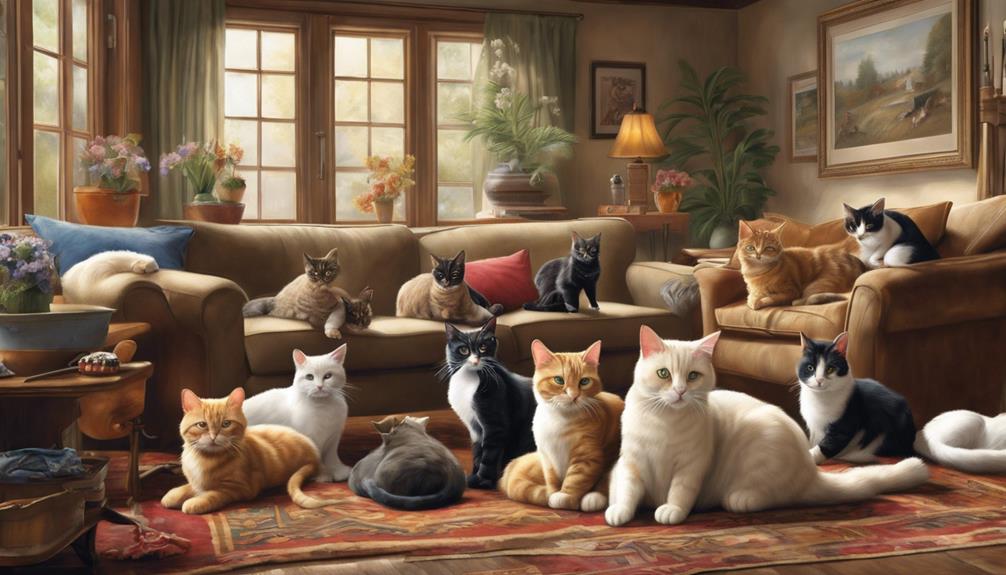
Feline Friends Breeder, known for its dedication to rescuing stray cats and kittens, offers a range of services including sheltering, adoptions, and spay/neuter programs. Located in Olympia, Washington, this reputable cat rescue organization is committed to saving feline lives and finding them loving homes.
Here are some key points about Feline Friends:
- Rescue Services: Feline Friends specializes in rescuing stray cats and kittens, providing them with a safe shelter until they're ready for adoption.
- Adoption Programs: The organization facilitates adoptions, matching cats and kittens with caring families who can provide them with forever homes.
- Spay/Neuter Initiatives: Feline Friends actively promotes spaying and neutering to control the feline population and reduce the number of homeless cats in the community.
Their dedication to these services has made Feline Friends Breeder a valuable resource for both felines in need and individuals looking to welcome a new furry friend into their lives.
Purrfect Paws Cattery
With a focus on breeding Scottish Fold and British Shorthair cats, Purrfect Paws Cattery in Eagan, Minnesota, stands out for its commitment to raising healthy and well-socialized kittens. The cattery guarantees that all their kittens come with pedigrees and health assurances, emphasizing the importance of the cats' well-being and quality of life. Here's a closer look at what sets Purrfect Paws Cattery apart:
| Aspect | Details |
|---|---|
| Location | Eagan, Minnesota |
| Specialization | Scottish Fold and British Shorthair cat breeding |
| Focus | Healthy and well-socialized kitten production |
| Assurances | Provides pedigrees and health assurances for all kittens |
Purrfect Paws Cattery's dedication to breeding top-quality Scottish Fold and British Shorthair cats shines through in their meticulous care and breeding practices. If you're looking for a reputable breeder that prioritizes the health and socialization of their kittens, Purrfect Paws Cattery is a fantastic choice.
Minnesota Meow Manor

Having established a strong reputation for breeding high-quality Maine Coon cats, Minnesota Meow Manor in Minnesota focuses on prioritizing health, temperament, and breed standards in their breeding program.
Here's why Minnesota Meow Manor stands out:
- Quality Breeding: Minnesota Meow Manor is dedicated to producing excellent Maine Coon kittens by adhering to strict health standards and selecting cats with exceptional temperaments.
- Responsible Practices: The cattery follows ethical breeding practices to guarantee the well-being of their cats and kittens, creating a nurturing environment for them to thrive.
- Exceptional Support: Prospective cat owners can rely on Minnesota Meow Manor for outstanding customer service and guidance throughout the adoption process, making sure each Maine Coon finds a loving home.
Minnesota Meow Manor's commitment to excellence and care makes them a top choice for those seeking a reputable breeder of Maine Coon cats in Minnesota.
North Star Cat Breeders
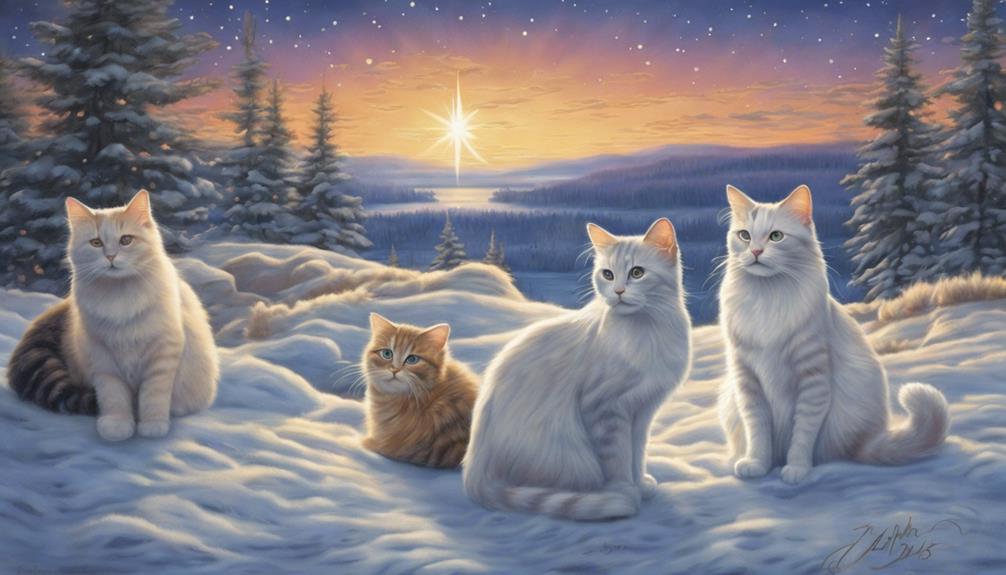
Moving on from our discussion of Minnesota Meow Manor, a notable cattery renowned for its dedication to breeding high-quality Maine Coon cats, we shift our focus to North Star Cat Breeders, another reputable establishment based in Minnesota.
North Star Cat Breeders is a well-respected cattery known for its specialization in breeding excellent, healthy cats, with a particular focus on specific breeds. What sets North Star Cat Breeders apart is their commitment to responsible breeding practices and the utmost care for their feline companions. They're dedicated to producing pedigreed kittens with outstanding temperaments and overall health.
The cattery's reputation is built on their adherence to breeding standards and their unwavering support for new cat owners. If you're looking for a furry friend that comes from a place of integrity and expertise, North Star Cat Breeders is a fantastic option in Minnesota. Their commitment to excellence and the well-being of their cats make them a standout choice for anyone seeking a feline companion.
Frequently Asked Questions
What Is the Most Wanted Breed of Cat?
The most wanted breed of cat is the Maine Coon in Minnesota. Known for their large size, friendly demeanor, and distinctive tufted ears, they are a top choice among cat lovers seeking a companion with unique characteristics.
How Do I Find a Reputable Cat Breeder in the Us?
To find a reputable cat breeder in the US, we suggest looking for breeders who are members of cat associations like TICA or CFA, visiting their facility, asking for references, and ensuring they provide health guarantees and vaccination records.
How Do I Know if My Cat Breeder Is Legit?
Wondering if your cat breeder is legit? Look for transparency, genetic testing, and support post-sale. Legitimate breeders prioritize health and adhere to strict standards. Avoid scams by asking for references and pedigree proof.
How Do I Find My Local Cat Breeder?
To find your local cat breeder, explore TICA's website, attend cat shows, join online cat breeding communities, connect with local cat clubs, and seek referrals from vets or fellow cat owners. It's important to verify credibility.
What are the best cat breeds for families in Minnesota?
When looking for the best cat breeds for families in Minnesota, consider consulting top minnesota cat breeders for recommendations. Some popular choices for families include Maine Coons, Ragdolls, and Abyssinians. These breeds are known for their friendly and social nature, making them great companions for families in Minnesota.
Conclusion
To sum up, when searching for the ideal feline friend in Minnesota, these top cat breeders are the cat's meow! With their commitment to quality breeding practices and affection for their furry companions, you can be confident that you'll discover a perfect match for your family.
Remember, when selecting a cat breeder, it's not just about finding a needle in a haystack – it's about finding a diamond in the rough.
Paul’s love for animals knows no bounds. As a dedicated writer and animal lover, Paul brings a unique perspective to our team. His firsthand experiences with various animals enrich our content and provide valuable insights into their behavior and needs. Whether he’s sharing tips for pet care or shedding light on pressing conservation issues, Paul’s passion for animals shines through in everything he does.
Cats
Hairball Treatment for Cats: The Ultimate Guide
Uncover the best strategies to tackle hairballs in cats, ensuring your feline companion stays happy and healthy – discover more in our comprehensive guide!
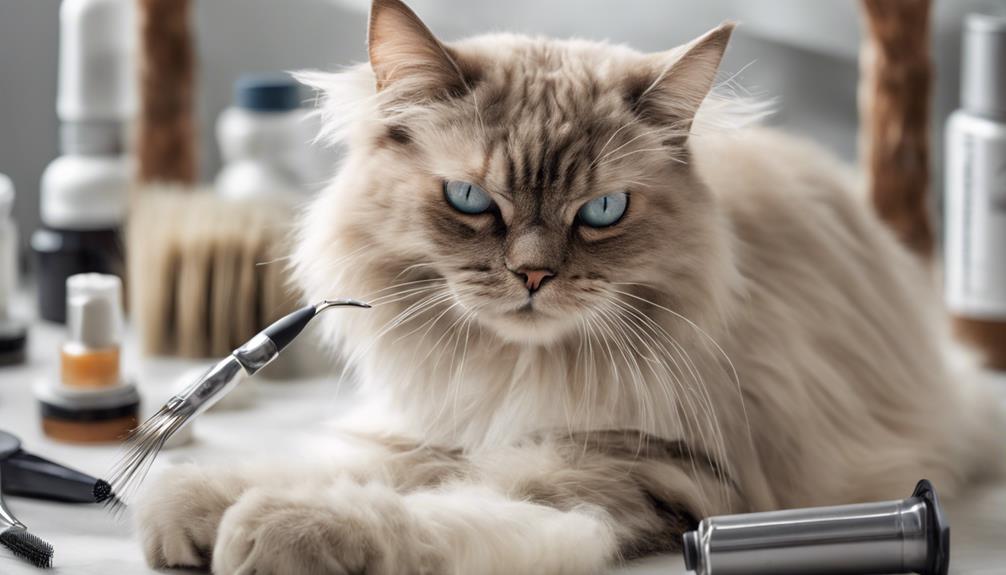
Dealing with cat hairballs? Causes include loose fur ingestion, barbed tongues, and long-haired cats. Symptoms like hacking, retching, and lethargy signal hairball issues. Treat with gels, high-fiber supplements, and vet consultation. Watch for coughing, bloating, or unusual tiredness, needing immediate vet care. Home remedies like pumpkin puree and probiotics aid relief. Prevent with hydration, grooming, fiber-rich diets, and specialized food. Seek vet help for severe symptoms or changes in behavior. Try fish oil, cat grass, and coconut oil as natural remedies. Stay informed for better cat care. More insights await in our comprehensive guide.
Key Takeaways
- Use hairball-control gels and high-fiber supplements.
- Consider fiber-loaded treats and specialized cat food.
- Consult a vet for persistent hairballs or symptoms.
- Maintain a healthy digestive system with dietary changes.
- Incorporate natural remedies like pumpkin puree and probiotics.
Causes of Cat Hairballs
Hairballs in cats often result from ingesting loose fur during grooming. Cats have a barbed tongue that catches loose hair while grooming, leading to the ingestion of this hair.
Long-haired cats and breeds that shed excessively are more prone to hairballs as they tend to ingest more fur during grooming sessions. The hair forms a mass in the digestive tract, causing irritation and blockages. As cats can't digest hair, it accumulates in their stomach and intestines, forming the hairball.
Ensuring that your cat has enough fiber in their diet can help move the hair through their system more effectively. Additionally, providing specialized cat foods designed to reduce hairball formation can be beneficial.
Regular grooming not only keeps your cat's coat in good condition but also helps minimize the amount of loose hair they ingest, ultimately reducing the risk of hairball formation.
Symptoms to Watch For

When it comes to our feline friends, keeping an eye out for common signs of hairballs is crucial. Watch for symptoms like hacking, gagging, and retching, as they could indicate your cat is struggling with hairball issues.
If your cat is showing persistent vomiting without expelling a hairball, it might be a red flag for a more serious underlying problem that requires prompt attention.
Common Signs of Hairballs
Experiencing frequent episodes of hacking and gagging could indicate that your cat is struggling with hairballs. These common signs of hairballs, such as retching and persistent vomiting without expelling a hairball, are important symptoms to watch for.
If your cat shows a lack of appetite, seems lethargic, or experiences digestive problems like constipation or diarrhea, hairballs could be the culprit. Keep an eye out for severe symptoms like a bloated abdomen or life-threatening blockages, as these indicate a serious hairball issue that needs immediate attention.
Understanding these hairball symptoms is crucial for effective hairball management and treatment. Remember, prevention and timely intervention play key roles in keeping your feline friend healthy and happy.
Behavioral Changes in Cats
Behavioral changes in cats, such as increased grooming or obsessive licking, may indicate potential hairball issues that require attention. Cats experiencing hairball problems may show signs of discomfort, like changes in appetite or refusal to eat. Additionally, avoidance of activities or hiding behavior could signal distress due to hairballs.
If your cat starts exhibiting excessive meowing, pacing, or seeking solitude, it might be struggling with hairball troubles. Keeping an eye out for these behavioral changes can help you identify and address hairball issues promptly, ensuring your feline friend stays happy and healthy. Remember, early detection and intervention are key in managing hairballs effectively. Be attentive to your cat's behaviors to provide the care they need.
Effective Treatment Options
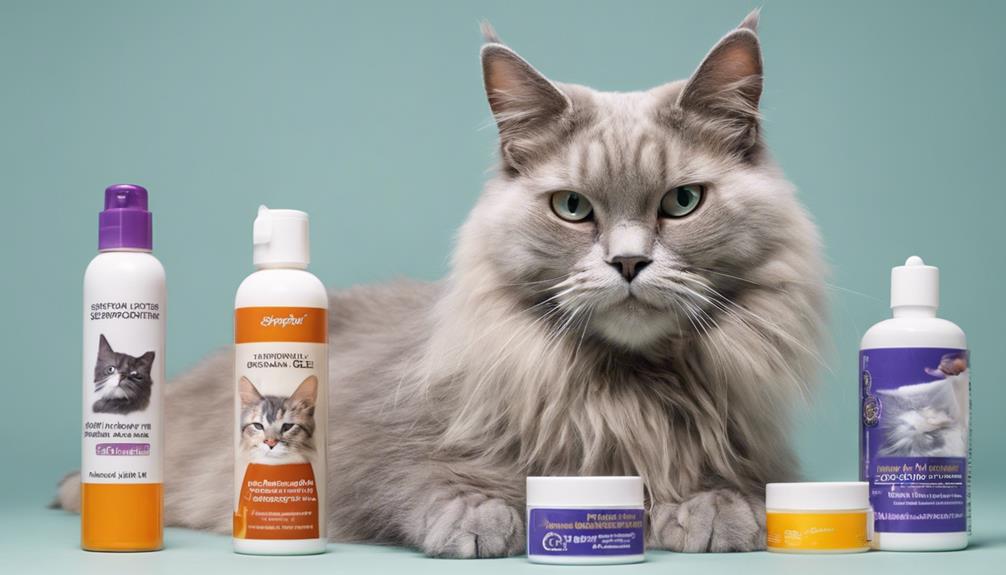
To effectively address hairball issues in cats, considering various treatment options is essential. Hairball-control gels, like Laxatone, act as lubricants to help cats pass hairballs more easily. High-fiber supplements can aid in sweeping hair through the digestive system, reducing hairball formation.
Cats may enjoy fiber-loaded treats, which not only manage hairballs but also serve as a tasty solution. Switching to high-fiber cat food is another effective way to control and prevent hairballs in cats. If your feline companion experiences frequent hairballs or related symptoms, consulting a vet is crucial for proper treatment.
These options provide practical ways to address hairball concerns and ensure your cat's well-being. By incorporating these treatments into your cat's routine, you can help them maintain a healthy digestive system and minimize the discomfort associated with hairballs.
Veterinary Intervention Indicators
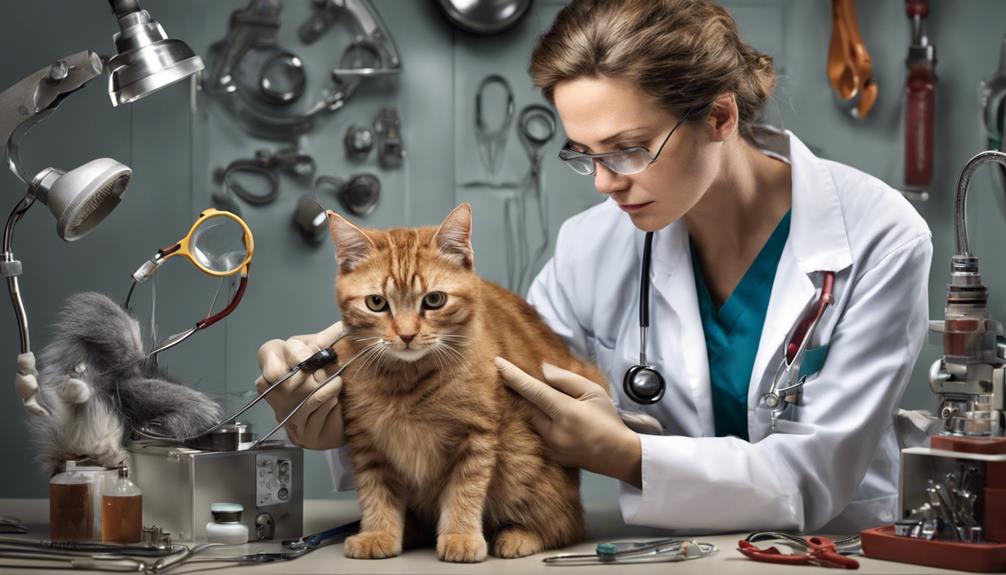
Upon observing persistent vomiting without hairball expulsion in cats, it becomes evident that veterinary intervention may be necessary to address potential underlying issues. Some indicators that your feline friend may need professional assessment include:
- Coughing: Persistent coughing alongside hairball issues could point to a more serious condition.
- Constipation or Diarrhea: These symptoms may signal an obstruction or gastrointestinal problem.
- Bloated Abdomen: A distended belly in conjunction with hairball troubles may require immediate attention.
- Lethargy: Unusual tiredness beyond normal hairball discomfort might indicate a more significant problem.
- Loss of Appetite or Difficulty Drinking: These signs could suggest an urgent need for veterinary care in hairball-related cases.
Home Remedies for Relief
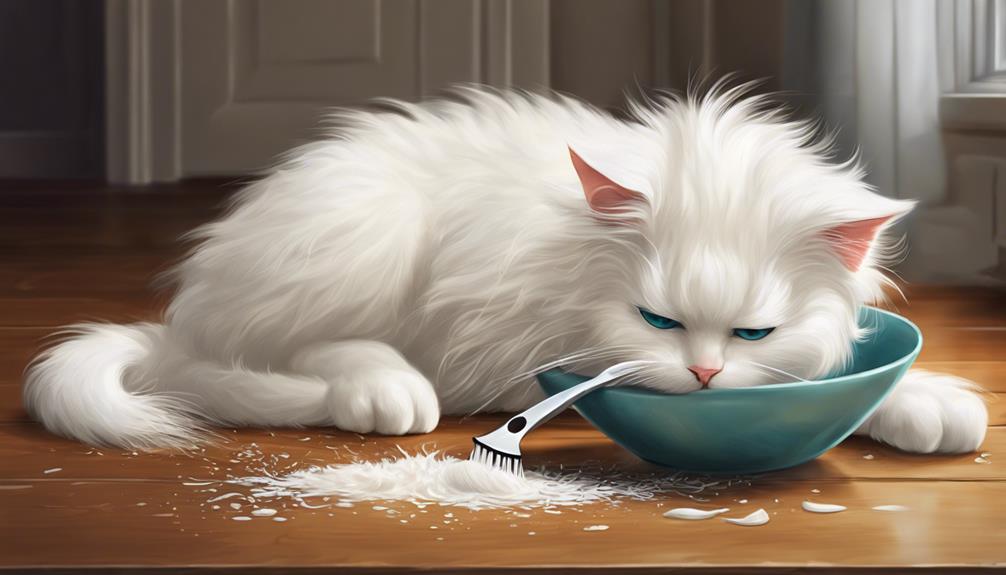
When looking for ways to help your cat with hairball troubles, consider natural remedies like:
- Pumpkin puree
- Cat grass
- Coconut oil
- Probiotics
These options can aid in digestion, induce vomiting to eliminate hairballs, act as a natural lubricant, and promote gut health to reduce hairball formation.
Additionally, incorporating hairball-control treats with natural ingredients into your cat's diet regularly can help manage and prevent hairballs effectively.
Natural Hairball Remedies
Exploring natural hairball remedies offers cat owners effective ways to alleviate their feline companions' discomfort and promote digestive health. Here are some simple remedies to help your cat with hairball issues:
- Pumpkin Puree: Aids digestion and helps hair pass through the digestive tract.
- Coconut Oil: Acts as a natural lubricant to ease the passage of hairballs.
- Plain Yogurt: Introduces beneficial bacteria to aid in digestion and reduce hairball formation.
- Olive Oil: Helps lubricate the digestive system, facilitating the elimination of hairballs.
- Grass or Catnip: Encourages natural vomiting to expel hairballs and promote digestive health.
These remedies can provide relief and support your cat's overall well-being.
Effective Dietary Changes
What dietary changes can help provide relief for cats suffering from hairball issues at home? Introducing high-fiber cat food aids in hairball digestion, while specialized diets recommended by veterinarians can target specific needs. Wet diets or canned food increase moisture content in the digestive system, promoting hairball passage. Hairball-control treats with added fiber offer digestive support for your feline companion. For tailored advice, consult with a vet for personalized dietary recommendations. To help you visualize the options available, we've compiled a table below:
| Dietary Changes | Benefits | Recommended Options |
|---|---|---|
| High-fiber cat food | Aids in hairball digestion | Quality brands |
| Specialized diets | Target specific needs | Vet-recommended options |
| Wet diets | Increases moisture content | Canned food varieties |
| Hairball-control treats | Offers digestive support | Fiber-enriched treats |
| Added fiber | Improves digestion | Supplements |
Preventing Future Hairball Issues

To prevent future hairball issues in your cat, regularly brushing their fur is essential to reduce loose hair and minimize hairball formation. Brushing not only helps in maintaining a healthy coat but also prevents excessive shedding, which can lead to hairballs.
Additionally, consider the following tips to further prevent hairball problems:
- Provide a high-fiber diet: A diet rich in fiber aids in moving hair through the digestive system, reducing the likelihood of hairballs.
- Use hairball-control products: Gels, treats, or supplements specifically designed to help with hairball prevention can be beneficial.
- Encourage hydration: Ensure your cat has access to fresh water at all times to support digestion and help prevent hairballs.
- Consult with a veterinarian: Seek personalized advice from a vet on the best hairball prevention strategies tailored to your cat's specific needs.
- Stay consistent with grooming: Regular cat grooming not only keeps their coat healthy but also reduces the amount of loose fur that can contribute to hairballs.
Frequently Asked Questions
What Is the Best Treatment for Hairballs in Cats?
For hairballs in cats, the best treatment involves specialized cat foods, hairball gels, regular grooming, and high-fiber supplements. These options help prevent hairball formation and aid in their passage through the digestive system.
How Do You Get a Cat to Pass a Hairball?
To help our cat pass a hairball, we encourage grooming, offer hairball control treats, increase fiber intake, keep them hydrated, and monitor behavior. If issues persist, we seek veterinary advice promptly for our furry friend's well-being.
What if My Cat's Hairball Won't Come Up?
When a cat's hairball won't come up, it's vital to act swiftly. Excessive efforts can lead to serious issues like choking. Urgent veterinary care is crucial, offering options like sedation or surgery for non-passable hairballs.
Does Vaseline Help Cats With Hairballs?
No, Vaseline doesn't help cats with hairballs. It can be harmful if ingested, leading to health issues. Safer options like hairball-control gels or high-fiber diets are recommended. Consult a vet for the best advice.
Conclusion
In conclusion, hairballs are a common issue for cats that can be easily managed with proper treatment and prevention.
Did you know that on average, a cat will produce one hairball every 1-2 weeks?
By recognizing the causes, symptoms, and treatment options, you can help your feline friend stay healthy and comfortable.
Remember to consult with your veterinarian for any concerns and try out some of the home remedies to provide relief for your cat.
Paul’s love for animals knows no bounds. As a dedicated writer and animal lover, Paul brings a unique perspective to our team. His firsthand experiences with various animals enrich our content and provide valuable insights into their behavior and needs. Whether he’s sharing tips for pet care or shedding light on pressing conservation issues, Paul’s passion for animals shines through in everything he does.
Cats
Can Cats Eat Tuna in Oil Safely?
Pondering if tuna in oil is safe for cats? Dive into the risks and benefits to ensure your feline's well-being.
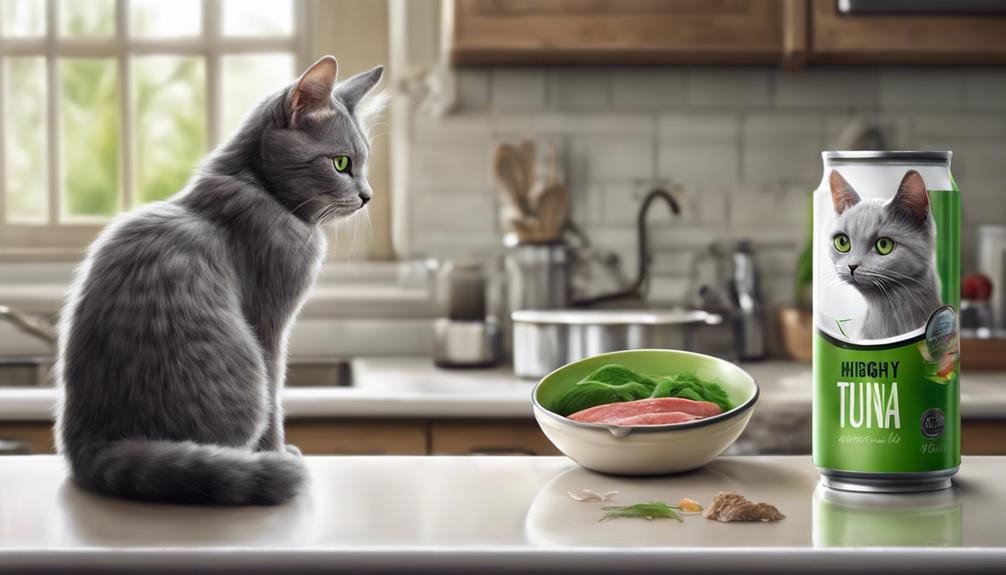
Cats can eat tuna in oil, but it may not be the safest choice. The high fat content in oil-packed tuna can lead to obesity and digestion problems. Opt for tuna in water for a better alternative. While tuna does offer nutritional value, moderation is key. Watch for signs of mercury poisoning, especially with excessive consumption. Consider age-appropriate portions, and consult a vet for dietary advice. Safeguard your cat's health by prioritizing a balanced diet. Remember, a healthy feline diet goes beyond just tuna. Your cat's well-being is paramount. More insights on feline nutrition await.
Key Takeaways
- Tuna in oil can harm cats' digestive systems due to high fat content.
- Opt for tuna in water for safer consumption.
- Excessive tuna in oil can lead to obesity and digestive issues.
- Monitor for signs of mercury poisoning from tuna.
- Consult a vet for advice on a balanced diet for cats.
Risks of Tuna in Oil for Cats
When feeding our feline friends, it's crucial to be aware of the risks associated with giving them tuna in oil. Cats are known for their love of fish, but when it comes to tuna, we need to be cautious. Tuna in oil can be harmful to our cats' delicate digestive systems. The high calorie and fat content in oil-packed tuna can lead to obesity and gastrointestinal issues in our furry companions. It's essential to consider the impact of their diet on their overall health and well-being.
Feeding our cats tuna in oil may seem like a tasty treat for them, but the potential risks outweigh the momentary pleasure. To ensure the safety of our cats' diet, opt for tuna in water instead. This small adjustment can make a significant difference in preventing unwanted health issues in our beloved feline friends. Let's prioritize our cats' health by making informed choices when it comes to feeding them.
Benefits of Tuna in Oil for Cats
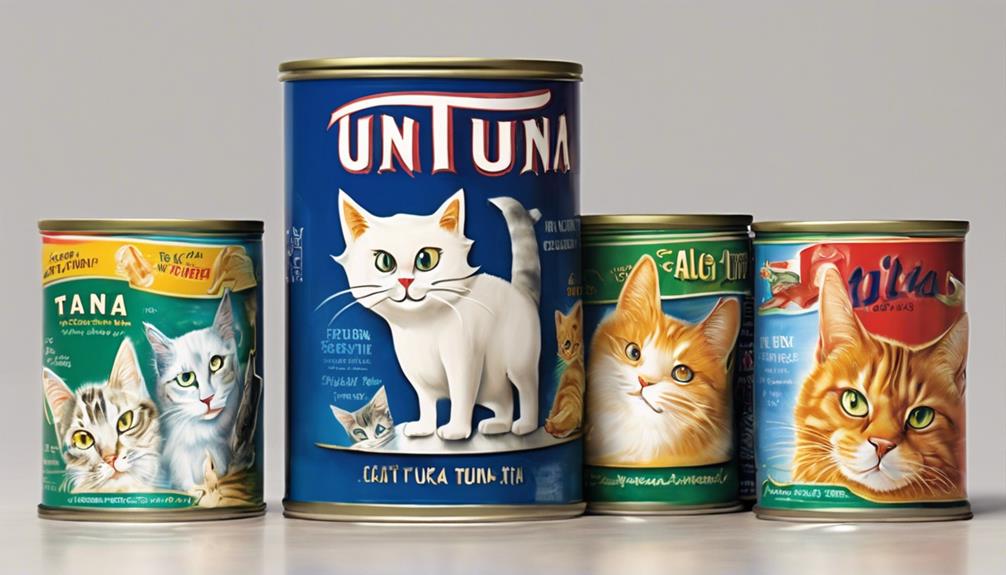
Tuna in oil can offer some nutritional value for cats, with its high protein content and omega-3 fatty acids. However, it's crucial to feed it in moderation to prevent potential health issues.
Nutritional Value for Cats
Indulging cats in tuna in oil may seem appealing, but considering its nutritional value, there are significant drawbacks to be mindful of.
While tuna in oil can be a source of protein for cats, it lacks the complete and balanced nutrition necessary for feline health. Opting for tuna in oil may not provide essential fatty acids, vitamins, and minerals vital for a cat's well-being.
Additionally, there's a risk of heavy metal contamination in tuna, which can be harmful to cats if consumed regularly.
To ensure your feline friend receives a safe and balanced diet, it's advisable to choose cat food specifically formulated to meet their nutritional needs rather than relying on tuna in oil as a primary source of nutrition.
Omega-3 Benefits
Considering the numerous benefits of Omega-3 fatty acids found in tuna oil, cats can experience improved heart health, reduced inflammation, enhanced joint health, and overall well-being.
These essential fatty acids not only support a healthy heart but also help in reducing inflammation, which is beneficial for cats, especially those with joint issues.
Additionally, Omega-3 can contribute to healthier skin and a shiny coat. The cognitive function of cats may also benefit from these fatty acids, promoting overall wellness.
However, it's crucial to remember that tuna in oil has a high-calorie content, so moderation is key to prevent weight-related issues.
Moderation Is Key
With the numerous benefits that Omega-3 fatty acids from tuna oil offer to cats, it's important to remember that moderation is key for ensuring their well-being and preventing any potential health issues.
Tuna in oil contains healthy fats that can promote skin and coat health in cats when given in controlled amounts.
While cats may find tuna in oil to be a special treat due to its taste, excessive consumption can lead to weight gain and digestive issues.
Monitoring the portion sizes and frequency of tuna in oil is crucial to prevent any potential health problems from arising.
Safe Amount of Tuna in Oil

When it comes to feeding your cat tuna in oil, it's crucial to be mindful of the amount they consume.
Too much tuna in oil can lead to weight gain and digestive issues in cats.
It's important to remember that moderation is key when offering tuna in oil to your feline friend.
Tuna Oil Consumption
Consuming tuna in oil poses potential health risks for cats due to its high calorie and fat content, making it advisable to limit their intake of this particular type of tuna. To ensure your feline friend stays healthy, it's best to opt for tuna in water or fresh tuna as safer alternatives. Here is a helpful table outlining the risks associated with tuna in oil for cats:
| Potential Risks | Effects on Cats |
|---|---|
| High Calorie Content | Weight Gain |
| Potential Digestive Issues | Gastrointestinal Upset |
| High Fat Content | Pancreatitis |
| Excessive Consumption | Health Problems |
Keeping your cat's diet in check can prevent these issues and promote their well-being. Remember, moderation is key when it comes to treating your beloved pet!
Health Risks Involved
Opting for tuna in oil as a dietary choice for cats presents significant health risks due to its high calorie and fat content. The rich oil content in tuna can lead to digestive issues and gastrointestinal upset in our feline friends.
Additionally, the high fat content in tuna oil can contribute to weight gain, obesity, and even pancreatitis in cats. It's essential to be mindful of the potential health risks associated with feeding tuna in oil to our beloved pets.
To ensure their well-being, opting for tuna in water or fresh tuna is a safer choice. Let's prioritize our cats' health by making informed decisions about their diet to prevent any adverse effects that could arise from the consumption of tuna in oil.
Raw Tuna Vs. Tuna in Oil

Comparing raw tuna to tuna in oil reveals significant differences in nutritional value and potential impact on a cat's digestion. When it comes to canned tuna, especially tuna in oil, it's crucial to consider the high calorie content and the risk of digestive issues it poses for our feline friends.
Cats, being obligate carnivores, may find it challenging to digest the added oil present in tuna in oil. This can lead to gastrointestinal upset and potential health complications due to the high fat content. Moreover, tuna in oil is less hydrating for cats compared to tuna in water, which could further exacerbate digestive problems.
Therefore, opting for tuna in water is undeniably the safer choice to safeguard your cat's health and well-being. By choosing the right type of tuna for your cat, you can ensure they enjoy their treat without facing unnecessary risks to their digestive system.
Health Implications of Tuna in Oil

In considering the health implications of tuna in oil for cats, one must be wary of the high fat content that can lead to digestive issues. The excessive fat in tuna in oil can contribute to obesity in cats, posing various health risks.
Cats may experience gastrointestinal upset and even pancreatitis from consuming tuna in oil due to the added oil content. It's crucial to note the calorie content and fat content in tuna in oil, as they can have detrimental effects on a cat's well-being.
Opting for tuna in water or fresh tuna is a safer choice to avoid these potential health issues associated with tuna in oil. By being mindful of the risks posed by the high fat content in tuna in oil, one can help safeguard their feline companions from experiencing digestive problems and other related health concerns.
Guidelines for Serving Tuna in Oil

Considering the potential health risks associated with tuna in oil for cats, it's important to establish clear guidelines for serving this type of tuna to ensure the well-being of our feline companions.
When it comes to feeding tuna to cats, opt for specifically formulated cat food with tuna that's low in carbohydrates and has health benefits. If you choose to offer tuna in oil, do so in small amounts to minimize the risks of feeding high sodium content to your cat. Always remember that the high-fat content in tuna oil can lead to obesity and pancreatitis in cats, so it's crucial to be cautious.
To maintain your cat's digestive health, it's recommended to avoid tuna in oil altogether and instead go for tuna in water. By following these guidelines and being mindful of the potential risks, you can ensure that your furry friend enjoys tuna safely while reaping its nutritional benefits.
Age Considerations for Tuna Consumption

When discussing the age considerations for tuna consumption in cats, it's essential to prioritize their developmental stage and dietary needs. Kittens aged 6 to 10 weeks can enjoy a small amount of neat canned tuna as an occasional treat. However, because young kittens' bodies are more sensitive, caution is advised when introducing tuna into their diet.
While it's okay to feed your cat tuna at a young age, it shouldn't replace their primary source of nutrition, which should come from balanced kitten food. When choosing tuna for your feline friend, opt for 100% pure chunk light tuna in water to ensure safe consumption. This type of tuna minimizes the risk of mercury poisoning, which can be harmful to your cat's health.
As responsible cat parents, it's crucial to be mindful of the types of tuna we include in our cat's diet to support their overall well-being and growth.
Frequently Asked Questions
Can I Give My Cat Canned Tuna in Oil?
We recommend avoiding canned tuna in oil for cats. It's best to opt for tuna in water to prevent digestive issues and weight gain. High calorie content in oil can lead to health problems. Let's keep our feline friends safe and healthy!
What Is the Best Canned Tuna for Cats?
We love sharing that the best canned tuna for our feline friends is chunk light tuna in water without additives. It keeps them happy and healthy. Remember, always opt for no preservatives or salt for their well-being.
How Much Canned Tuna Is Safe for Cats?
Eating canned tuna in moderation is safe for cats. Too much can lead to health issues. We recommend canned tuna in water for our feline friends. Let's prioritize their well-being by offering a balanced diet.
Is Tuna in Oil Good for Cats With Constipation?
When looking at cats with constipation, tuna in oil isn't the best choice due to its high fat content, which can aggravate digestive issues. Opting for tuna in water is a safer alternative for hydration.
Conclusion
In conclusion, while cats can safely enjoy tuna in oil in moderation, it's important to consider the risks and benefits. Remember, too much of a good thing can lead to health issues for your feline friend. So, keep those tuna treats limited to maintain a balanced diet.
After all, we wouldn't want our cats to start swimming in oil themselves! Stay informed, stay cautious, and keep those kitty treats in check.
Paul’s love for animals knows no bounds. As a dedicated writer and animal lover, Paul brings a unique perspective to our team. His firsthand experiences with various animals enrich our content and provide valuable insights into their behavior and needs. Whether he’s sharing tips for pet care or shedding light on pressing conservation issues, Paul’s passion for animals shines through in everything he does.
Cats
Famous Female Cats in Movies: Top 10
Yearning for a glimpse into the world of iconic female cats in movies?
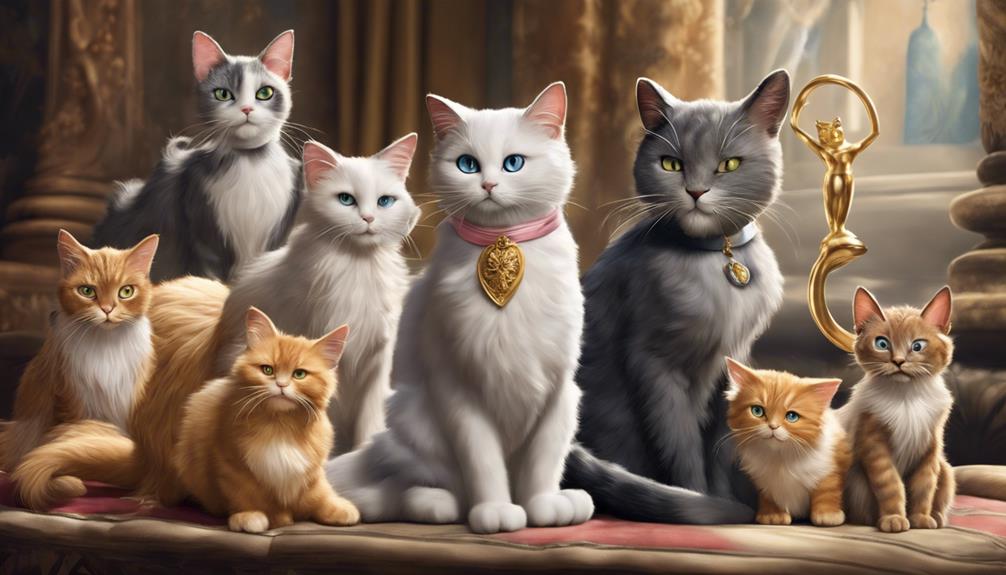
In the realm of movies, iconic female cats have captivated audiences with their memorable roles. From Holly Golightly's Cat in "Breakfast at Tiffany's" symbolizing companionship to Church bringing sinister vibes in "Pet Sematary," these feline characters steal the show. Jonesy in "Alien" provides comfort in a sci-fi horror setting, while Goose shines in "Captain Marvel" with adorableness and plot importance. Films like "The Adventures of Milo and Otis" and "Harry Potter" also feature beloved cat characters worth mentioning. Each of these famous female cats brings a unique charm to their respective films, adding depth and entertainment.
Key Takeaways
- Holly Golightly's Cat from "Breakfast at Tiffany's" is an iconic feline character symbolizing companionship.
- Church from "Pet Sematary" is a dark and transformative cat with sinister consequences in the narrative.
- Jonesy from "Alien" provides comfort and hope amid extraterrestrial danger, becoming a symbol of humanity.
- Milo and Otis from "The Adventures of Milo and Otis" showcase the escapades and talents of animal actors.
- Goose from "Captain Marvel" steals the spotlight with adorable appearance, crucial plot role, and unique origin from comics.
Breakfast at Tiffanys (1961)
In 'Breakfast at Tiffany's' (1961), we meet Holly Golightly, a flighty and cat-obsessed character who shares a special bond with her ginger tabby named Cat.
Cat, the feline companion of Holly Golightly, isn't just any ordinary cat in the movie but a symbol of companionship and attachment. Holly affectionately refers to Cat as her 'poor slob without a name,' showcasing her deep connection to the ginger tabby.
Throughout the film, the relationship between Holly Golightly and Cat highlights themes of love, freedom, and the search for identity. Cat's presence not only adds warmth and humor to the storyline but also reflects Holly's own feelings of isolation and longing for connection.
As we follow the adventures of Holly and Cat in 'Breakfast at Tiffany's,' we're drawn into a world where love knows no bounds, even between a quirky socialite and her beloved ginger tabby.
Pet Sematary (1989 and 2019)
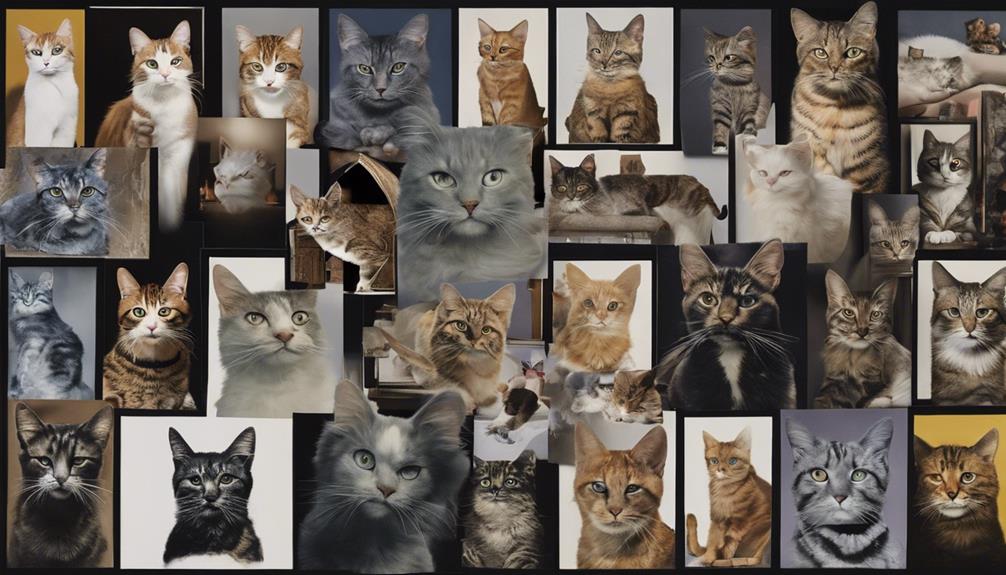
Church, the iconic feline character in both the original 1989 movie and the 2019 remake of Pet Sematary, embodies loyalty and eeriness as it undergoes a dark transformation after burial in the mysterious graveyard.
In the 2019 adaptation, four different cats were employed to bring Church to life, emphasizing the significance of this feline actor in the narrative. Church's presence in both versions of Pet Sematary adds a chilling and supernatural element to the story, captivating audiences with its haunting portrayal.
The cat character of Church serves as a poignant reminder of the sinister consequences that arise when the natural order of life and death is disrupted. Through its unsettling transformation, Church becomes a symbol of dread, leaving a lasting impression on viewers.
Pet Sematary continues to stand out in the realm of horror movies, largely due to the captivating performance of Church, the enigmatic and unsettling feline at the heart of the tale.
Alien (1979)
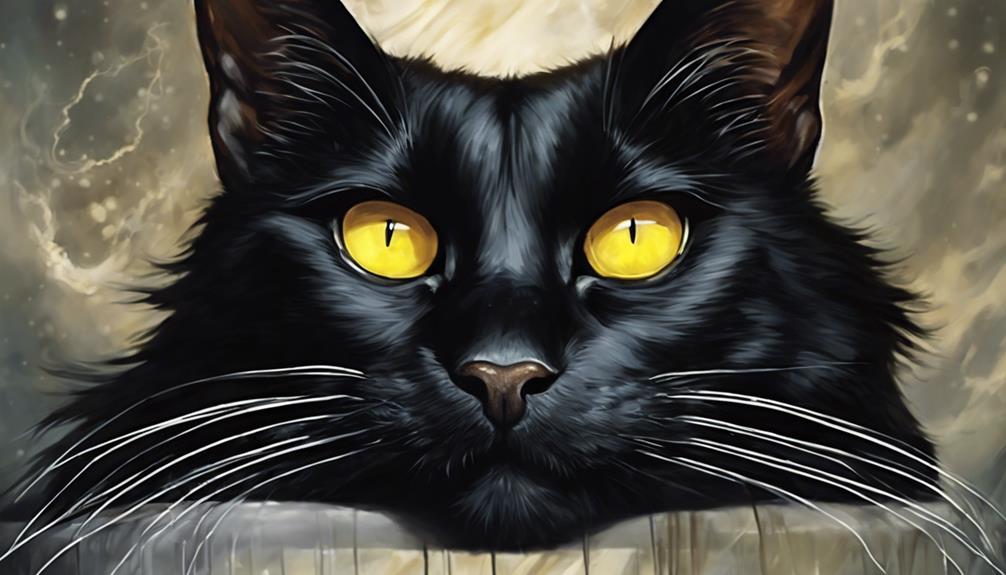
In the movie Alien (1979), Jonesy the ginger cat becomes an iconic character, influencing memorable movie moments.
Jonesy's presence not only provides comfort to the crew but also showcases the bond between humans and animals in the face of extraterrestrial danger.
The cat's role adds a unique and endearing aspect to the sci-fi horror film.
Iconic Alien Character
How did Jonesy, the ginger cat from Alien (1979), impact the atmosphere aboard the Nostromo spaceship?
Well, let's paint you a picture:
- Picture Jonesy's soft fur gently brushing against the crew's hands, offering solace in the midst of chaos.
- Imagine the soothing purrs resonating through the dimly lit corridors, a beacon of comfort in the eerie silence.
- Visualize the crew members finding moments of respite as they interacted with Jonesy, a reminder of the world beyond the spaceship's metal walls.
- Envision the subtle wag of Jonesy's tail, a small gesture that spoke volumes about the power of companionship in the face of unknown terrors.
Jonesy's presence wasn't just that of a pet; it was a symbol of hope and humanity in a world overrun by alien nightmares.
Female Cats Influence
Among the notable female cats in movies, Jonesy from Alien (1979) stands out for her impactful role aboard the Nostromo spaceship. Jonesy, the ginger cat, provided comfort and companionship to the crew, offering a sense of normalcy amidst the terror of the alien threat. Her survival instincts and agility were crucial in aiding the crew through perilous situations.
The bond between Jonesy and Ripley highlighted the importance of human-animal connections in times of crisis. Despite being a non-speaking character, Jonesy's actions and presence significantly contributed to the film's atmosphere and dynamics. The subtle interactions between Jonesy and the crew added depth to the storyline, showcasing the importance of compassion and unity in the face of danger.
Memorable Movie Moments
One standout moment in Alien (1979) that continues to captivate audiences is the intense confrontation between Ripley and the alien in the cramped confines of the spaceship.
Ripley's heart races as she faces the sleek, otherworldly Alien in a battle of survival. The Nostromo's dimly lit corridors amplify the tension, echoing with the sound of Ripley's quickened breaths. The Alien's hisses pierce the silence, signaling imminent danger to Ripley and her crewmates. Jonesy, the loyal ginger cat, watches from a safe distance, a silent witness to the unfolding chaos, offering a sense of companionship amidst the terror.
This scene not only highlights the film's suspense but also emphasizes the importance of companionship, even in the face of unimaginable threats.
The Adventures of Milo and Otis (1989)
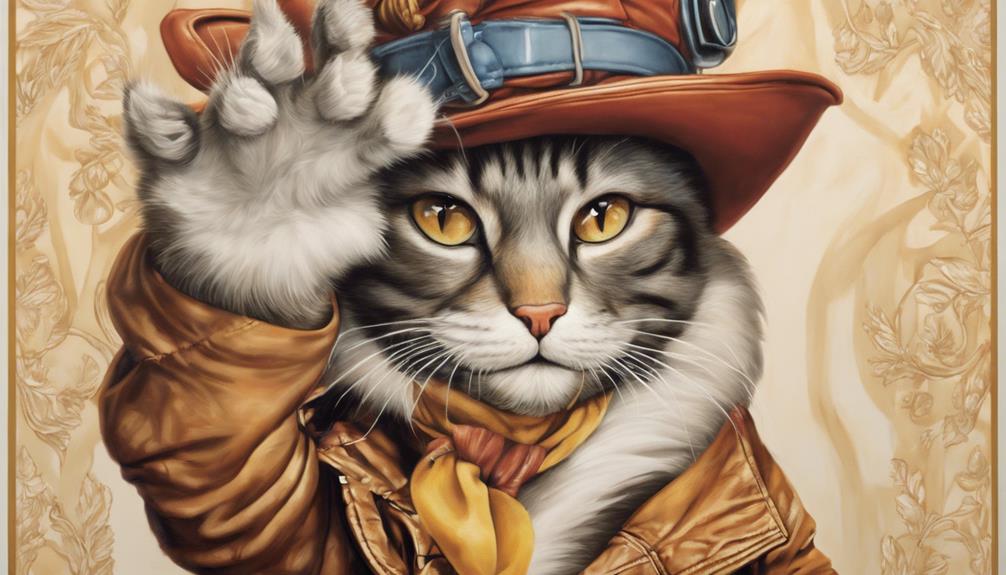
'The Adventures of Milo and Otis' (1989) follows the captivating escapades of a cat named Milo and a pug named Otis, originating from a Japanese film and gaining cult status despite controversies surrounding animal welfare during production.
This family-friendly movie showcases the incredible talent of animal actors, delivering impressive stunts and heartwarming performances that have captured the hearts of viewers over the years.
Despite facing allegations of animal cruelty, the film remains a beloved choice for animal lovers due to the endearing moments shared between Milo the cat and Otis the pug.
The movie's mix of adventure, friendship, and heartwarming scenes has solidified its place as a classic in the realm of cat movies.
Fans of animal-centric films will appreciate the genuine connection between the two main characters, making 'The Adventures of Milo and Otis' a must-watch for those seeking a wholesome and entertaining movie experience.
Captain Marvel (2019)

Goose steals the spotlight in Captain Marvel (2019), showcasing his adorable appearance and unexpected abilities as a Flerken.
- As a Flerken, Goose resembles an ordinary cat but possesses dangerous abilities that surprise and captivate audiences.
- Throughout the movie, Goose's actions aren't only adorable but also crucial to the plot, making him a beloved character among fans.
- The character of Goose is actually based on Chewie from the Captain Marvel comics, with some unique modifications that add depth to his role.
- Goose's presence in the film extends beyond just being a cute pet; he plays a significant part in key moments, solidifying his importance in the storyline.
Fans have embraced Goose with open arms, leading to merchandise and widespread popularity within the Marvel Cinematic Universe. His charm and unexpected nature make him a standout character in Captain Marvel, adding a delightful twist to the superhero narrative.
The Princess Diaries (2001)

Playing a pivotal role in The Princess Diaries (2001), Fat Louie emerges as the iconic male cat known for his playful and regal demeanor alongside Mia Thermopolis. As Mia's royal companion, Fat Louie steals scenes with his charming presence, adding humor and charisma to the film. His memorable moments have made him a fan favorite, captivating audiences with his endearing antics.
Whether lounging in regal fashion or playfully engaging with Mia, Fat Louie's unique personality shines through, creating a special bond with viewers. The dynamic between Mia Thermopolis and Fat Louie showcases a heartwarming connection that adds depth to the storyline, making their interactions a delightful aspect of the movie.
With his expressive feline features and lovable antics, Fat Louie brings a touch of whimsy and joy to The Princess Diaries, solidifying his place as a beloved character in the hearts of many.
Inside Llewyn Davis (2013)
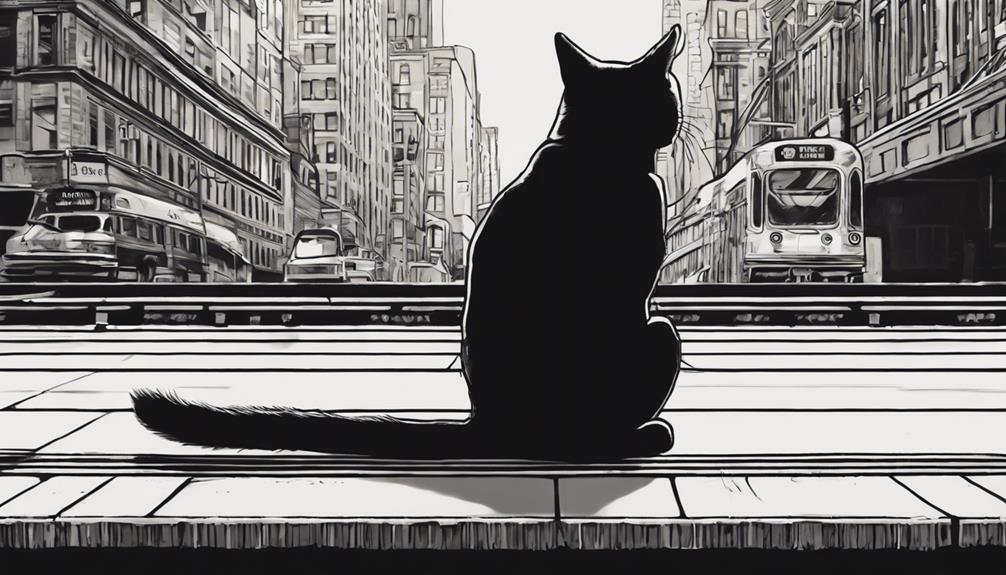
In Inside Llewyn Davis (2013), a cat named Ulysses takes on a significant role, symbolizing the struggles and journey of the film's protagonist. Ulysses, portrayed by multiple look-alike cats, seamlessly weaves through the storyline, adding depth to the relationship dynamics between characters.
Here's a glimpse into Ulysses' impact:
- Ulysses, with his enigmatic gaze, mirrors the internal turmoil of Llewyn Davis, reflecting his inner conflicts and uncertainties.
- The feline's independent nature resonates with Llewyn's own sense of isolation and longing for connection in the bustling cityscape.
- Through playful interactions with Ulysses, viewers witness moments of vulnerability and tenderness in Llewyn that are otherwise hidden beneath his tough exterior.
- Ulysses' presence acts as a silent observer, shedding light on the unspoken emotions and intricate ties that bind the characters together in this poignant tale.
The subtle yet profound role of Ulysses adds a layer of complexity to the narrative, making him an integral part of the emotional tapestry within Inside Llewyn Davis.
Kikis Delivery Service (1989)
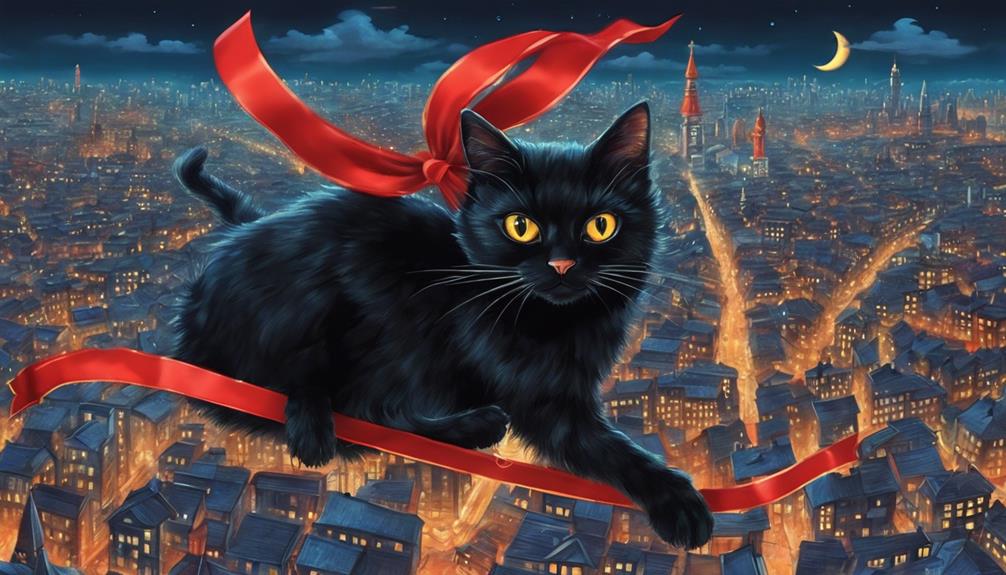
In 'Kiki's Delivery Service' (1989), Kiki's magical flying broom steals the show, but let's not forget about Jiji, the sassy cat who adds humor and sass to the storyline.
The dynamic between Kiki and Jiji showcases a bond that goes beyond words, highlighting the importance of companionship in the magical world they navigate together.
Jiji's witty and supportive nature complements Kiki's journey, making them a memorable duo in this heartwarming tale.
Kikis Magical Flying Broom
Kiki's magical flying broom in 'Kiki's Delivery Service' (1989) serves as a vital tool for the young witch's journey of self-discovery and growth, enabling her to navigate the skies with independence and determination.
- As Kiki zooms through the clouds on her broom, the wind tousles her hair, emphasizing her freedom.
- The broom's sleek design reflects Kiki's elegance and grace as she soars above the picturesque landscapes.
- With each delivery she makes on her broom, Kiki gains confidence in her abilities and strengthens her sense of self.
- The broom's enchanting flight symbolizes Kiki's transition from uncertainty to embracing her magical heritage and purpose.
Kiki's magical flying broom not only aids her in her deliveries but also acts as a metaphor for her personal journey towards maturity and self-realization.
Jiji the Sassy Cat
Jiji the sassy black cat, known for his witty remarks and loyal companionship to Kiki, plays a significant role in the animated film 'Kiki's Delivery Service' (1989). Voiced by the talented Phil Hartman in the English dub, Jiji's humorous banter with Kiki adds depth and humor to the story.
Throughout the movie, Jiji helps Kiki adapt to her new surroundings and supports her in her delivery service endeavors. His charming personality and strong bond with Kiki make him a standout character, showcasing the importance of animal companionship and friendship.
Jiji's presence not only provides comedic relief but also underscores the theme of loyalty and support. In the world of animated films, Jiji has become an iconic and beloved feline figure, cherished for his role in Kiki's journey.
Harry Potter Series

Half-Kneazle Crookshanks, Hermione's loyal and intelligent cat in the Harry Potter series, plays a crucial role in exposing Peter Pettigrew's true identity in the Prisoner of Azkaban. Crookshanks' distinctive appearance with bushy fur, squashed face, and piercing amber eyes adds to his mysterious charm.
Here are some fascinating facts about Crookshanks:
- Sharp Intelligence: Crookshanks is known for his exceptional intelligence, which aids Hermione and the gang in solving intricate mysteries.
- Loyalty to Hermione: Crookshanks displays unwavering loyalty to Hermione, supporting her through thick and thin in their magical adventures.
- Pottermore Mention: J.K. Rowling herself highlighted Crookshanks' significance in aiding Sirius Black during the tumultuous events of the Prisoner of Azkaban.
- Instrumental Role: Beyond being a mere pet, Crookshanks proves to be an instrumental character in the series by helping unveil the true intentions of Peter Pettigrew, ultimately changing the course of events in the wizarding world.
Homeward Bound: The Incredible Journey (1993)
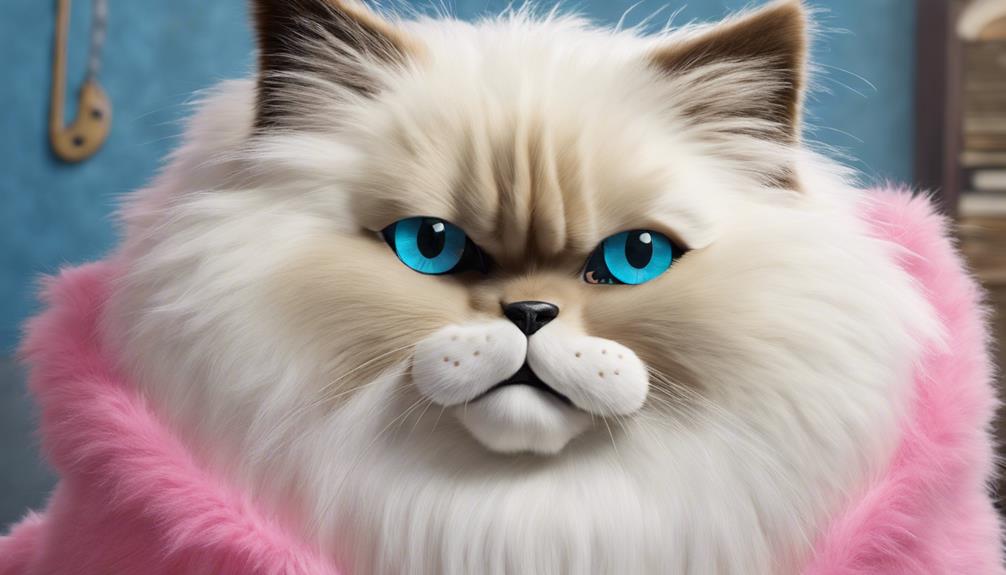
Sassy, the determined and loyal feline from Homeward Bound: The Incredible Journey (1993), joins two dogs on a cross-country adventure in search of their family.
Voiced by Sally Field, Sassy's character brings humor and excitement to the heartwarming journey.
Her resourcefulness and interactions with the dogs make her a beloved and memorable part of the film.
Top Female Cat Characters
Embarking on a cross-country journey with two dogs, the tenacious and adventurous female cat in 'Homeward Bound: The Incredible Journey' (1993) adds a unique charm to the heartwarming animal adventure. Voiced by Sally Field, Sassy's determination and courage make her a memorable character in the film. Here's why she stands out:
- Sassy fearlessly navigates through various challenges, showcasing her bravery.
- Her witty remarks and sassy attitude bring humor and liveliness to the group dynamics.
- Sassy's interactions with the dogs and other animals highlight her caring nature.
- Sally Field's vocal performance breathes life into Sassy, giving depth to the feline character's personality.
Homeward Bound Representation
Representing a tale of friendship and determination, 'Homeward Bound: The Incredible Journey (1993)' portrays the inspiring journey of Sassy, a tenacious cat, and her loyal canine companions searching for their family across the country.
Sassy's unwavering determination and resourcefulness shine through as she overcomes obstacles alongside her canine pals. Voiced by the talented Sally Field, Sassy's character adds humor and sass to the group dynamic, making her a beloved part of this heartwarming family film.
Throughout the perilous journey, Sassy's loyalty and courage are evident, showcasing her as a standout character who embodies the spirit of resilience and companionship. This classic movie captures the essence of unity and perseverance, making Sassy a memorable feline heroine in the world of cinema.
Frequently Asked Questions
Who Is the Most Famous Fictional Cat?
We believe the most famous fictional cat is Garfield. Created in 1978 by Jim Davis, Garfield's known for loving lasagne, hating Mondays, and delivering witty sarcasm. Appearing in comics, TV, and movies, Garfield's an enduring cultural icon.
What Is the Most Famous Cat in Hollywood?
We believe the most famous cat in Hollywood is Jonesy from 'Alien' (1979). Jonesy, an orange tabby, brings comfort and tension in the sci-fi horror film. His loyalty and unpredictability make him iconic, enhancing the storyline.
Who Is the Famous Crazy Cat Lady?
We know the famous crazy cat lady you're curious about. She's an iconic character, deeply entwined with feline companions. Her eccentricity and love for cats captivate us all. Let's uncover her intriguing story together.
Who Is the Most Famous Cat of All Time?
We believe the most famous cat of all time would be Garfield. He's iconic for his love of lasagne and disdain for Mondays, charming audiences with his wit and humor in movies, TV shows, and comics.
Conclusion
In the world of movies, female cats have left a lasting paw print on our hearts. From the iconic Holly Golightly's feline companion in 'Breakfast at Tiffany's' to the mysterious Jonesy in 'Alien,' these purr-fect stars have stolen the show.
Just like cats have nine lives, these famous feline characters have brought joy and entertainment to audiences of all ages. Their whiskers may be fictional, but their impact is very real.
Paul’s love for animals knows no bounds. As a dedicated writer and animal lover, Paul brings a unique perspective to our team. His firsthand experiences with various animals enrich our content and provide valuable insights into their behavior and needs. Whether he’s sharing tips for pet care or shedding light on pressing conservation issues, Paul’s passion for animals shines through in everything he does.
-

 Vetted2 months ago
Vetted2 months ago15 Best Cat Foods for Managing Hyperthyroidism – Vet Approved and Feline Friendly
-

 Vetted2 months ago
Vetted2 months ago15 Best Dog Foods for Kidney Disease – Expert Recommendations for Your Pet's Health
-
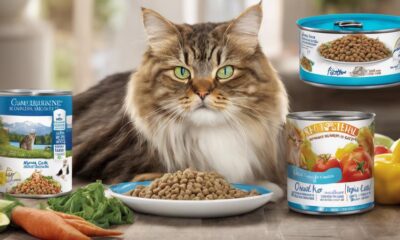
 Vetted2 months ago
Vetted2 months ago15 Best Wet Cat Foods for Older Cats to Keep Them Healthy and Happy
-

 Vetted2 months ago
Vetted2 months ago15 Best Fresh Dog Food Delivery Services for Your Pup's Health and Happiness
-

 Vetted2 months ago
Vetted2 months ago14 Best Homemade Dog Food Recipes Your Pup Will Love – Vet Approved & Nutritious
-

 Animal Facts2 months ago
Animal Facts2 months agoSpring Animals: A Guide to Seasonal Wildlife
-

 Cats1 month ago
Cats1 month agoCat Weight Chart by Age: Kitten to Senior in Lbs
-

 Cats2 weeks ago
Cats2 weeks agoTop 5 Cat Breeders in Arkansas: A Guide




















